What is a Power Amplifier? Types, Classes, Applications
2021-09-15
An amplifier is an electronic device used to increase the magnitude of voltage/current/power of an input signal. It takes in a weak electrical signal/waveform and reproduces a similar stronger waveform at the output by using an external power source.
What is a Power Amplifier?
A power amplifier is an electronic amplifier designed to increase the magnitude of power of a given input signal. The power of the input signal is increased to a level high enough to drive loads of output devices like speakers, headphones, RF transmitters etc. Unlike voltage/current amplifiers, a power amplifier is designed to drive loads directly and is used as a final block in an amplifier chain.
The input signal to a power amplifier needs to be above a certain threshold. So instead of directly passing the raw audio/RF signal to the power amplifier, it is first pre-amplified using current/voltage amplifiers and is sent as input to the power amp after making necessary modifications. You can observe the block diagram of an audio amplifier and the usage of power amplifier below.

In this case a microphone is used as an input source. The magnitude of signal from the microphone is not enough for the power amplifier. So first it is pre-amplified where its voltage and current are increased slightly. Then the signal is passed through tone and volume controls circuit which makes aesthetic adjustments to the audio waveform. Finally, the signal is passed through a power amplifier and the output from power amp is fed to a speaker.
Types of Power Amplifiers
Depending on the type of output device that is connected, power amplifiers are divided into the following three types.
Audio Power Amplifiers
This type of power amplifiers is used for increasing the magnitude of power of a weaker audio Signal. The amplifiers used in speaker driving circuitries of televisions, mobile phones etc. come under this category.
The output of an audio power amplifier ranges from a few milliwatts (like in headphone amplifiers) to thousands of watts (like power amplifiers in Hi-Fi/Home theatre systems).
Radio Frequency Power Amplifiers
Wireless transmissions require modulated waves to be sent over long distances via air. The signals are transmitted using antennas and the range of transmission depends on the magnitude of power of signals fed to the antenna.
For wireless transmissions like FM broadcasting, antennas require input signals at thousands of kilowatts of power. Here, Radio Frequency Power amplifiers are employed to increase the magnitude of power of modulated waves to a level high enough for reaching required transmission distance.
DC Power Amplifiers
DC power amplifiers are used to amplify the power of a PWM (Pulse Width Modulated) signals. They are used in electronic control systems which need high power signals to drive motors or actuators. They take input from microcontroller systems, increase its power and feed the amplified signal to DC motors or Actuators.
Power Amplifier Classes
There are multiple ways of designing a power amplifier circuit. The operation and output characteristics of each of the circuit configurations differs from each other.
To differentiate the characteristics and behavior of different power amplifier circuits, Power Amplifier Classes are used in which letter symbols are assigned to identify the method of operation.
They are broadly classified into two categories. Power amplifiers designed to amplify analog signals come under A, B, AB or C category. Power amplifiers designed to amplify Pulse Width Modulated (PWM) digital signals come under D, E, F etc.
The most commonly used power amplifiers are the ones that are used in audio amplifier circuits and they come under classes A, B, AB or C. So let’s take a look at them in detail.
Class A Power Amplifier
Analog waveforms are made up of positive highs and negative lows. In this class of amplifiers, the entire input waveform is used in the amplification process.
A single transistor is used to amplify both the positive and negative halves of the waveform. This makes their design simple and makes class A amplifiers the most commonly used type of power amplifiers. Although this class of power amplifiers are superseded by better designs, they are still popular among hobbyists.
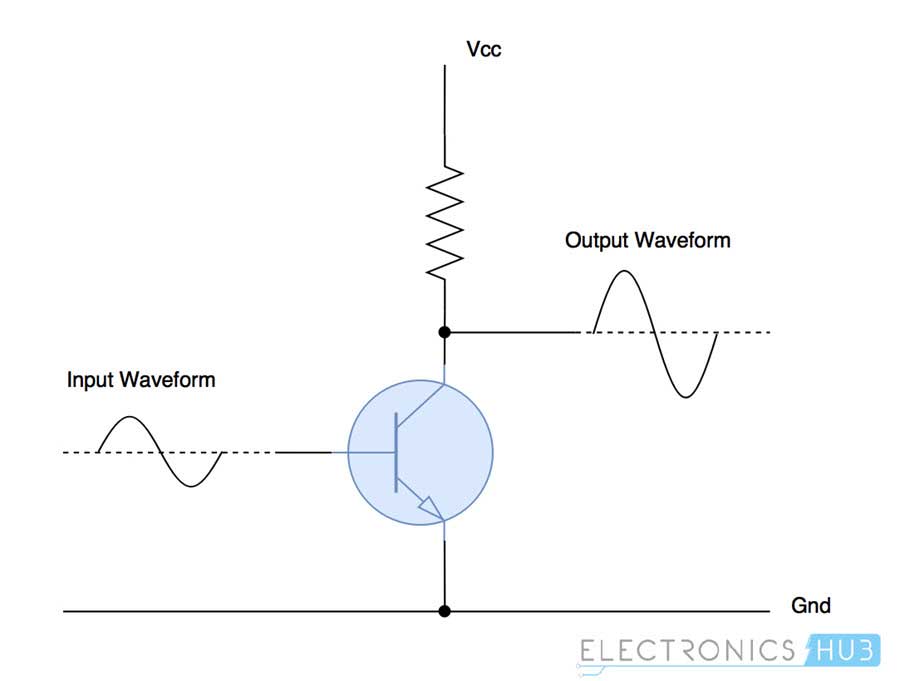
In this class of amplifiers, the active element (the electronic component used for amplifying, which is transistor in this case) is in use all the time even if there is no input signal. This generates lot of heat and reduces the efficiency of class A amplifiers to 25% in normal configuration and 50% in a transformer coupled configuration.
The conduction angle (the portion of waveform used for amplification, out of 360°) for class A amplifiers is 360°. So, the signal distortion levels are very less allowing better high frequency performance.
Class B Power Amplifier
Class B power amplifiers are designed to reduce the efficiency and heating problems present in the class A amplifiers. Instead of a single transistor to amplify the entire waveform, this class of amplifiers use two complementary transistors.
One transistor amplifies positive half of the waveform and the other amplifies negative half of the waveform. So each active device conducts for one half (180°) of the waveform and two of them when combined amplify the entire signal.
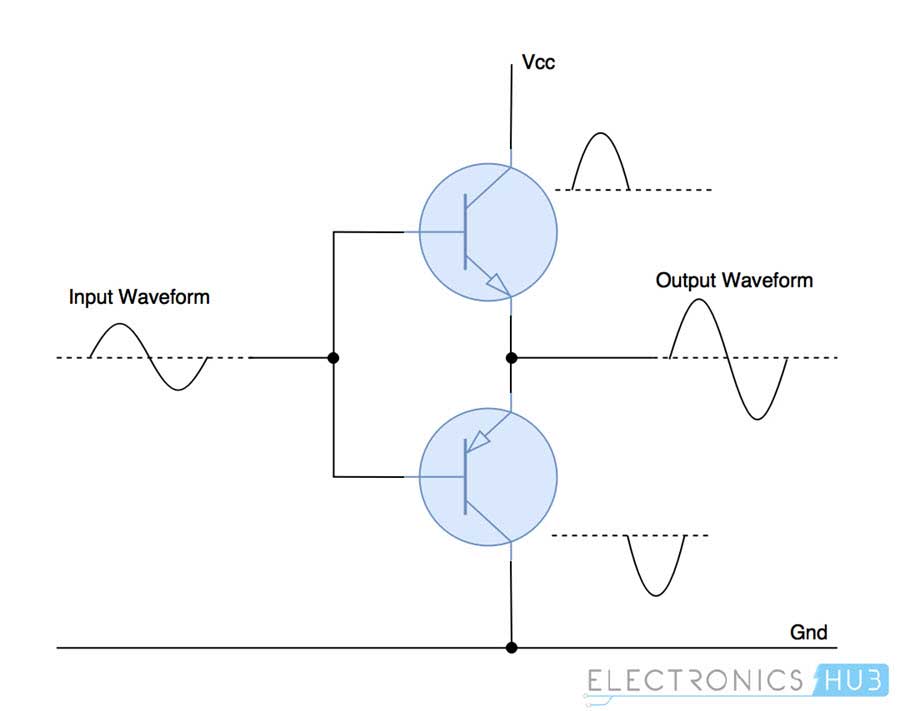
The efficiency of class B amplifiers is improved a lot over class A amplifiers because of two transistor designs. They can reach a theoretical efficiency of about 75%. Power amplifiers of this class are used in battery operated devices like FM radios and transistor radios.
Because of superposition of two halves of the waveform, there exists a small distortion at the crossover region. To reduce this signal distortion, class AB amplifiers are designed.
Class AB Power Amplifier
Class AB amplifiers are a combination of class A and class B amplifiers. This class of amplifiers are designed to reduce the less efficiency problem of class A amplifiers and distortion of signal at crossover region in class B amplifiers.
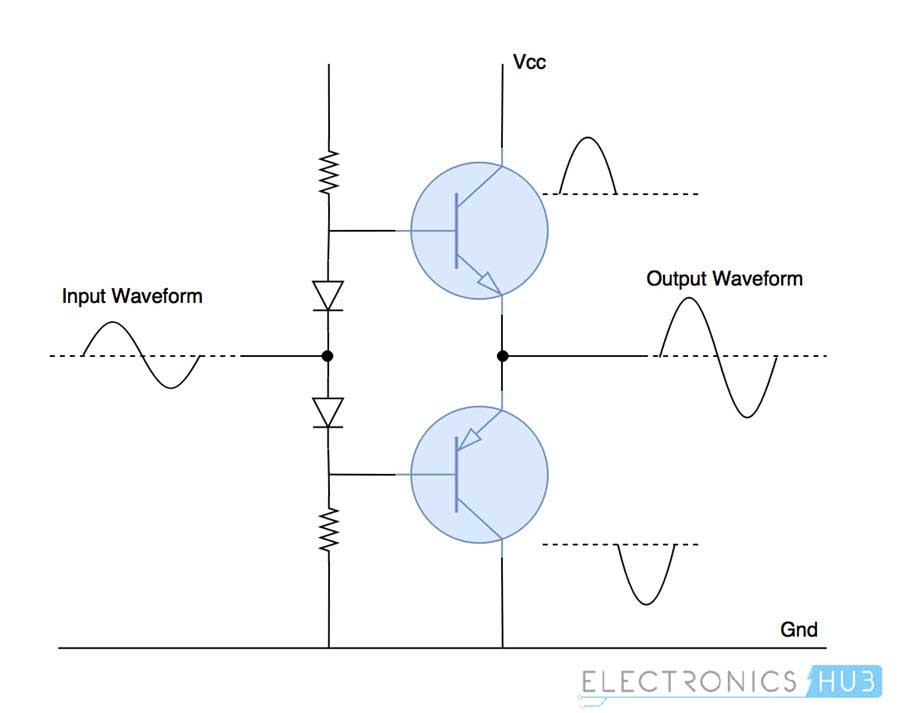
It maintains high frequency response like in class A amplifiers and good efficiency as in class B amplifiers. A combination of diodes and resistors are used to provide little bias voltage which reduces the distortion of waveform near the crossover region. There is a little drop in efficiency (60%) because of this.
Class C Power Amplifier
The design of class C power amplifiers allows greater efficiencies but reduces the linearity/conduction angle, which is under 90°. In other words, it sacrifices quality of amplification for increase in efficiency.
Lesser conduction angle implies greater distortion and so this class of amplifiers are not suited for audio amplification. They are used in high frequency oscillators and amplification of Radio Frequency signals.
Class C amplifiers generally contain a tuned load which filters and amplifies input signals of certain frequency, and the waveforms of other frequencies are suppressed.
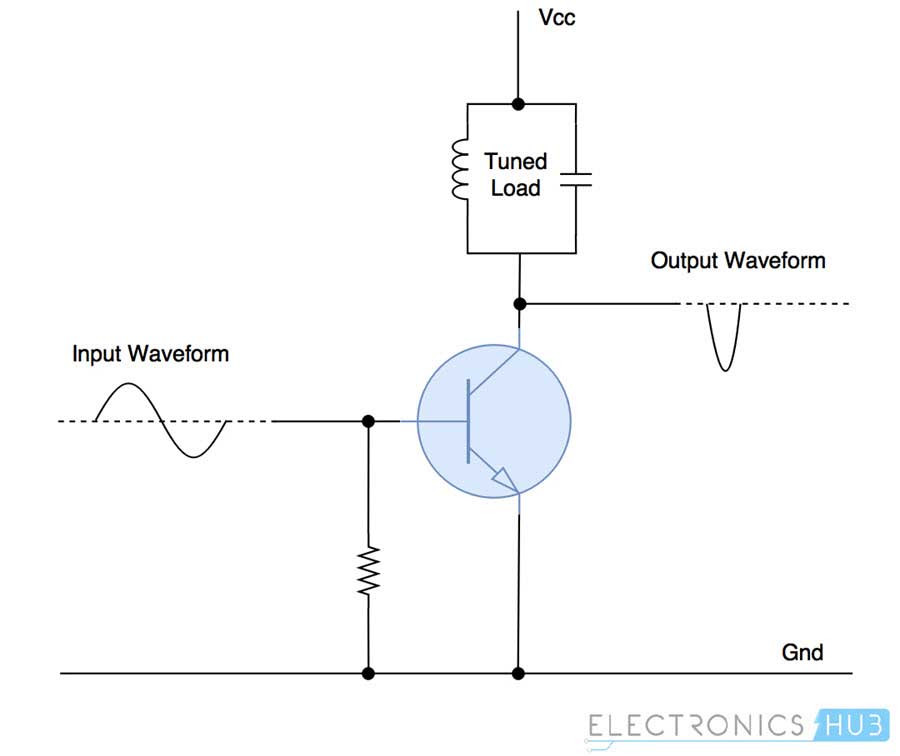
In this type of power amplifier, the active element conducts only when the input voltage is above a certain threshold, which reduces power dissipation and increases efficiency.
Other Power Amplifier Classes
Power amplifier classes D, E, F, G etc. are used to amplify PWM modulated digital signals. They come under the category of switching power amplifiers and turn the output either constantly ON or constantly OFF without any other levels in between.
Because of this simplicity, power amplifiers falling under the above-mentioned classes can reach theoretical efficiencies of up to (90-100) %.
Applications
Below are the applications of power amplifiers across different sectors:
•Consumer Electronics: Audio power amplifiers are used in almost all consumer electronic devices ranging from microwave ovens, headphone drivers, televisions, mobile phones and home theatre systems to theatrical and concert reinforcement systems.
•Industrial: Switching type power amplifiers are used for controlling most of the industrial actuator systems like servos and DC motors.
•Wireless Communication: High power amplifiers are important in transmission of cellular or FM broadcasting signals to users. Higher power levels made possible because of power amplifiers increases data transfer rates and usability. They are also used in satellite communication equipment.
5 Important Specifications to consider when choosing an amplifier
With so many features now built into amps it can be intimidating when buying one, but do they really improve the sound?
At Cambridge Audio, we don’t go in for unnecessary complications. We focus our efforts and budget only on specs that make a real difference to the sound you hear. When choosing an amplifier, look out for these specifications:
1. Power output:
Power output is roughly equivalent to how loud you can pump out music. The bigger the speakers or room, generally the more power you want (much to your neighbors and housemates dismay!) However, you probably don’t need as much power as you’d expect. Generally, 10W is pretty loud for average listening and 100W is enough to blow the roof off most parties!
Hint: Be sure to look at speaker sensitivity, since this has a big effect.
2. THD+N:
Total Harmonic Distortion + Noise (THD + N) is a measure of just how much effect the amplifier has on the sound output. More distortion generally means more colouration to the sound. The lower this figure, the closer the output of the amplifier will sound to the original recording. Of course, speakers will have the biggest effect on sound, so choose some that are well matched to your listening preference.
Hint: Lower numbers are better.
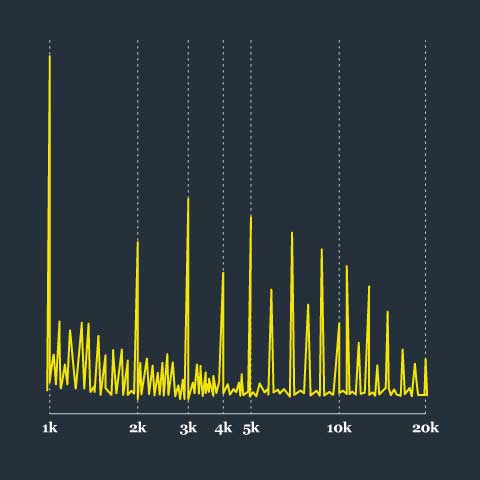
3. SNR (Signal to Noise Ratio):
If you stand in a quiet room, in the countryside, away from the hustle and bustle, you might notice noises you’ve never noticed before. The humming of a radiator or cars travelling down a nearby road for example. None of this is apparent when the kids are home with the TV blasting away, but that background noise is still there. An amplifier is the same, there is always a very small amount of noise from the electrons whizzing around inside. The goal is to make this background noise imperceptible, this means you hear more of the music and less of the noise. The measure of this is the signal to noise ratio.
Hint: Bigger numbers are better!
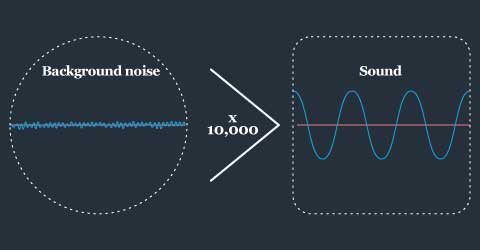
4. Crosstalk:
Left is Left, Right is Right and Crosstalk is a measure of how much undesirable left signal is mixed with right output. Amplifiers all being one box are doing their best to be separate boxes one per channel, splitting apart the signals to ensure when it reaches the speakers, you can tell that the singer is standing slightly to the left of the stage and the violins towards the right. The more crosstalk there is, the harder it is to pick out the positions of the instruments as stereo separation is affected.
Hint: With crosstalk, the larger the number following the minus sign (i.e. -60dB is not as good as -100dB) the greater the stereo separation.
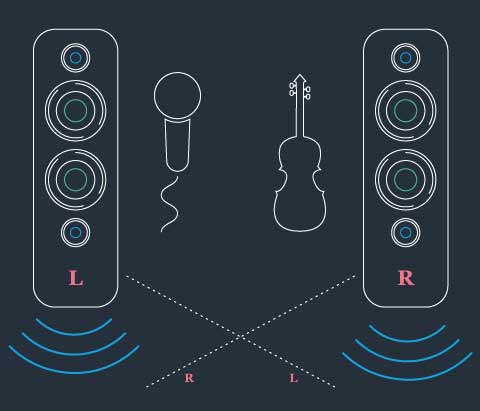
5. Inputs/Connections:
Can you connect up everything you want to? You’ll want to make sure you have enough inputs for everything you’re plugging in! Remember the different type of connections, like 3.5mm for iPods, Phono for turntables and USB for laptops and home theatre PC’s. They all have advantages and when there are a few options, choose the one which provides the best sound quality.
Hint: We separate out phono stages in our Azur products, and guarantee best performance as the signals from a turntable are very small and can be easily interfered with.



